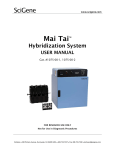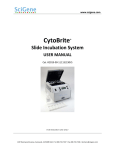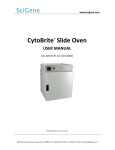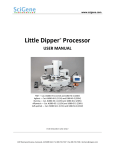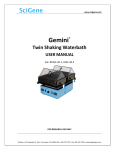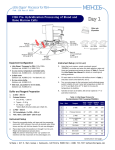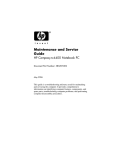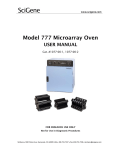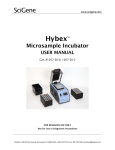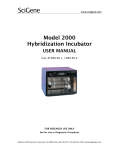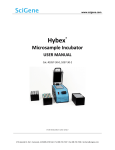Download Mai Tai Hybridization System Manual
Transcript
www.scigene.com Mai Tai® Hybridization System USER MANUAL Cat. #1075‐00‐1, 1075‐00‐2, 1075‐00‐5, 1075‐00‐6 FOR RESEARCH USE ONLY Not for Use in Diagnostic Procedures SciGene 1287 Reamwood Avenue, Sunnyvale, CA 94089 USA 408-733-7337 Fax 408-733-7336 [email protected] Mai Tai® Hybridization System — USER MANUAL Serial Number The following serial number identifies the specific instrument you have purchased and must be referenced when requesting service. A copy is affixed to the instrument. Technical Service: (408) 733‐7337, [email protected] Warranty SciGene warrants that the heating unit described in this manual shall be free of defects in materials and workmanship for a period of 12 months from date of delivery. This warranty does not cover removable rotators or accessories. In the event of a defect during the warranty period, SciGene’s limit of liability will be to provide replacement parts at no charge or, at its sole discretion, replace the product. The foregoing warranty is void in the event the unit was abused or modified or used in a manner inconsistent with its intended purpose. SciGene makes no other warranty, expressed or implied including warranties of merchantability and fitness for a particular purpose. In no event shall SciGene be liable for any direct, indirect, special, incidental or consequential damages or for any damages resulting from loss arising out of or in connection with the sale, use or performance of the product. Copyright Copyright ©2008‐2015 SciGene Corporation. All rights reserved. SciGene is a trademark of SciGene Corporation, Sunnyvale, CA. All other trademarks used in this manual are the property of their respective owners. Version 2.2, February 2015 1 (408) 733‐7337, [email protected] Mai Tai® Hybridization System — USER MANUAL Table of Contents I. SAFETY NOTICES ........................................................................................................................................ 3 A. Intended Use ................................................................................................................................................... 3 B. Instrument Safety ............................................................................................................................................ 3 C. Warnings ......................................................................................................................................................... 3 D. Cautions ........................................................................................................................................................... 3 E. Lifting and Moving the Unit ............................................................................................................................. 3 II. UNPACKING AND SET UP ........................................................................................................................... 4 A. Removing the Unit from the Carton ................................................................................................................ 4 B. Parts Provided ................................................................................................................................................. 4 C. Installation ....................................................................................................................................................... 4 III. USING YOUR OVEN ................................................................................................................................... 5 A. Oven Components and Controls ..................................................................................................................... 5 B. Closing and Opening the Door ........................................................................................................................ 6 C. Using the Temperature Controller .................................................................................................................. 6 D. Setting Rotator Speed ..................................................................................................................................... 6 E. Using the Jog Switch ........................................................................................................................................ 6 F. Calibrating the Oven Temperature.................................................................................................................. 6 G. Loading and Removing Rotators ..................................................................................................................... 7 IV. USING MAI TAI® HYBRIDIZATION CASSETTES ............................................................................................. 8 V. CLEANING AND STORING MAI TAI® CASSETTES ......................................................................................... 10 VI. MAINTAINING YOUR OVEN ...................................................................................................................... 11 H. Checking and Replacing Fuses ....................................................................................................................... 11 I. Replacing the Temperature Controller .......................................................................................................... 12 J. Maintaining the Rotator Drive System .......................................................................................................... 12 K. Cleaning ......................................................................................................................................................... 12 VII. TROUBLESHOOTING ............................................................................................................................ 13 VIII. SPECIFICATIONS ................................................................................................................................... 13 IX. ORDERING INFORMATION ........................................................................................................................ 13 X. DECLARATION OF CONFORMITY ............................................................................................................... 14 Version 2.2, February 2015 2 (408) 733‐7337, [email protected] Mai Tai® Hybridization System — USER MANUAL I. SAFETY NOTICES A. Intended Use This instrument is intended for the heating and incubation of laboratory samples. This instrument should only be used according to the instructions provided in this manual. If the equipment is used in a manner not specified by the manufacturer, the protection provided by the equipment may be impaired. B. Instrument Safety Before operating the instrument, read the information in this section concerning hazards and potential hazards. Ensure that anyone involved with the instrument’s operation is instructed in both general safety practices for laboratories and specific safety practices for the instrument. C. Warnings Failure to comply with the following warnings that are affixed to the product can lead to possible personal injury or death. D. Cautions Failure to comply with the following cautionary statement affixed to the product may lead to possible personal injury. Items heated in the oven should be handled with heat protective gloves. Open all closed vessels heated in the oven with the opening pointed away from you to avoid contact with heated aerosols. E. Lifting and Moving the Unit The rotating oven you have purchased weighs approximately 70 lbs (32 kg). Use caution when lifting the unit to protect you and others from personal injury. It is strongly recommended that two people lift the unit simultaneously to keep it balanced and to share the load. Version 2.2, February 2015 3 (408) 733‐7337, [email protected] Mai Tai® Hybridization System — USER MANUAL II. UNPACKING AND SET UP A. Removing the Unit from the Carton Position the shipping carton on the floor close to the location of intended installation. Remove the foam inserts from the top of the unit. Position a person at the front and one at the back of the oven. Grip the recessed edges along the top of the unit and lift it straight up and out of the shipping carton taking care to keep it balanced. Place it on the bench or table where it will be installed. Carefully inspect the unit for damage. If there is evidence of damage, do not discard the shipping materials since they may be needed to return the unit. B. Parts Provided The following items are included with the system. Model 777 Microarray Oven Mai Tai Rotator Mai Tai Cassette(s) Oven Power Cord Oven Drip Pan User Manual C. Installation 1. Placement Place the unit on a stable, level surface within a few feet of the power source. Avoid locating it below a shelf where solutions are stored. A spill may enter the electrical compartment through the vent holes on the top of the unit and cause damage. Ensure there is adequate clearance along the front and right side of the oven to open the door completely. There should be a minimum clearance of 3 inches along the top and back panels for air circulation. 2. Connecting the Power Plug the power cord provided into the back of the unit and then to a properly grounded outlet. Use only the power cord provided. 3. Powering On Turn power ON to the unit using the switch on the front of the unit. Version 2.2, February 2015 4 (408) 733‐7337, [email protected] Mai Tai® Hybridization System — USER MANUAL III. USING YOUR OVEN A. Oven Components and Controls SciGene ovens use a radiant heating system to warm the walls of the stainless steel interior, providing uniform heating of air within the rotator compartment. Operating temperature (ambient + 5 to 99°C) is regulated to ±0.2°C from set point by means of a high performance temperature controller (Watlow EZ‐Zone) and a sensitive Resistive Thermal Device (RTD) used as temperature sensor. The RTD is a stainless steel probe located at the top of the rotator compartment. SciGene ovens simplify calibration by incorporating a secondary thermocouple mounted with the primary RTD. Key Components: Temperature Controller ‐ used to set and observe chamber temperature Power Switch ‐ turns on power to the heater. Jog Switch – turns on rotator with door open at selected speed Rotator Speed Control ‐ turns on and controls rotator speed Door Latch – secures the door closed with button release to open Version 2.2, February 2015 5 (408) 733‐7337, [email protected] Mai Tai® Hybridization System — USER MANUAL B. Closing and Opening the Door To secure the door, press the door against the cabinet to close and push down the top lever. To open, press the lower latch release button. C. Using the Temperature Controller The oven is equipped with a Watlow EZ‐Zone temperature controller (shown at right). The controller has two LED displays and five buttons. The upper display shows ACTUAL temperature inside the chamber. The lower display shows the SET or programmed temperature. The up and down arrow buttons are used to adjust the desired temperature. Simply push the up and down arrows until the desired temperature is shown in the lower display. The oven adjusts the heat of the chamber until the SET temperature is attained. The advance button (circle icon) at lower left is used to scroll through parameters during calibration. It is not used during normal operation. The infinity button () is used for adjusting the power that is delivered to the chamber heaters or for exiting calibration mode. It is programmed at the factory to provide 100% power and should not be adjusted during normal operation. The EZ button on the left is for advanced functions not applicable to this oven model and should not be adjusted during normal operation. The controller is calibrated at the factory to provide accurate chamber temperatures from ambient +5 to 99°C. SciGene recommends checking calibration monthly. See section F. Calibrating Oven Temperature for details. D. Setting Rotator Speed The rotator is turned on and off and its speed of rotation controlled through the rotary switch. Turn the dial clockwise from its stopping point to turn on the rotator drive system and set the speed of rotation. Rotation speed is adjustable up to 80 RPM. E. Using the Jog Switch The jog switch is used to momentarily advance the rotator when the door is open. When the jog switch is pressed, the rotator will turn at the speed selected on the speed controller. It will not move if the speed controller is turned off or is set too low. F. Calibrating the Oven Temperature To ensure accurate (±0.5°C) oven temperatures, the performance of the Watlow EZ‐Zone controller should be periodically checked by comparing the temperature displayed on the controller to an accurate, NIST‐certified (National Institute of Standards and Technology) thermal measurement device. Calibration need only be performed at a single temperature (e.g. 65°C) to achieve accurate oven operating temperatures from ambient +5 to 99°C. SciGene recommends the calibration method below to achieve accurate oven temperatures. No other methods are recommended. Version 2.2, February 2015 6 (408) 733‐7337, [email protected] Mai Tai® Hybridization System — USER MANUAL 1. Calibration Check a. Turn on the oven, set to 65°C and allow temperature to stabilize (30 min). b. Connect a NIST‐certified digital thermometer (SciGene Cat. #1051‐52‐0) to the blue jack (secondary RTD) at the top back of the oven. c. Verify that the temperature shown on the digital thermometer matches that shown on the controller within ±0.5°C. If it does not, follow the steps below to adjust the controller. 2. Calibration Procedure d. Turn on the oven, set to 65°C and allow temperature to stabilize (30 min). e. Connect a NIST‐certified digital thermometer (SciGene Cat. #1051‐52‐0) to the blue jack at the top back of the oven. f. Calculate the difference in temperature shown on the controller to the digital thermometer. For example, if the controller displays 65.0°C and the thermometer displays 66.5°C, the difference (offset) is 1.5°C. g. On the controller, press the up and down arrows simultaneously for 3 seconds. The upper display will now read “A1” and the lower display “open”. h. Press the green circle button 3 times until the lower display shows “i.CA”. The upper display shows the offset value between the controller and thermometer when the unit was last calibrated. i. Use the up/down arrows to adjust the offset value to the temperature difference calculated in Step c. For example, if the controller displays a temperature 1.5°C lower than the thermometer, adjust the offset by adding 1.5 to the value shown. j. Press the key twice to return to the operation display. Your oven is now calibrated to provide accurate temperatures between ambient + 5 to 99°C. G. Loading and Removing Rotators All rotators are loaded and removed using the same two‐step process. When loading, first insert the end of the shaft that ends in a ball joint with alignment pin into the slotted bearing on the right wall of the chamber. The left end of the shaft is then placed into the bearing on the left side of the chamber. Reverse this procedure when removing the rotator. 1.) Place end of shaft on left bearing. 2.) Insert shaft ball with alignment pin into right bearing. Version 2.2, February 2015 7 (408) 733‐7337, [email protected] Mai Tai® Hybridization System — USER MANUAL IV. USING MAI TAI® HYBRIDIZATION CASSETTES With the Mai Tai Rotator installed, pre‐heat the hybridization oven to the desired incubation temperature. 1. Place the base plate on a flat surface such as a laboratory bench. 2. Place a gasket slide into each chamber in the cassette with the “Agilent” label facing up and aligned with the “barcode” side of the chamber, as shown in Figure 2. When placing the gasket slide, ensure the slide does not rest on the edge of the base plate (Figure 3). To familiarize new users with the placement technique, practice placing ordinary 1” x 3” (25 mm x 75 mm) glass slides into the chamber prior to running an experiment. 3. Pipette the labeled probe into each chamber of the gasket slide using the volumes shown in the table below for each gasket slide format. To prevent spilling or leaking, dispense the hybridization solution to the center of the gasket well without touching the gasket with the pipette tip (Figure 4). Gasket Format 1x microarray 2x microarray 4x microarray Probe Volume 520 μl 260 μl 110 μl 4. Holding array at the ends with the array side down and ensuring that the barcode side matches with the one on the gasket slide, bring the array down slowly holding it horizontal to the gasket slide (Figure 5). Placing the array evenly onto the gasket slide is crucial to prevent spilling or leakage. Version 2.2, February 2015 8 (408) 733‐7337, [email protected] Mai Tai® Hybridization System — USER MANUAL Use Agilent arrays or microarrays from other sources that are compatible with the Agilent gasket slides. 5. When all arrays have been placed, make sure all assemblies are laid flat against the base plate. See Figure 6 for examples of proper and improper placement. 6. Place the cover plate over the arrays with the barcode window matching the barcodes on the array. See Figure 7 showing correct placement and orientation of the cover plate. 7. Tighten the thumb screws by hand until stopped. Do NOT use tools. 8. Rotate the cassette to ensure that the bubbles move freely inside each array chamber. For optimal hybridization, it is best to have one large bubble which moves freely around the chamber when rotated. After assembly, ensure that there are no stationary bubbles in any array chamber when the assembly is rotated. Stationary bubbles can be released by gently tapping each corner of the assembly on a firm surface as it is rotated. 9. Place the assembly into the Mai Tai Rotator in the pre‐heated oven. Raise the spring bar and load a Mai Tai Cassette by sliding the cassette into an empty slot. When rotating multiple cassettes, load equal numbers of cassettes on opposing sides of the rotator to balance weight. 10. Rotate the Mai Tai Rotator at the speed recommended by the microarray manufacturer. 11. At the completion of the incubation period, remove the cassette(s) from the rotator and allow to cool for a few minutes. Loosen thumbscrews and remove the top plate. 12. One‐at‐a‐time, remove the array gasket slide “sandwich” and separate them while submerged in the buffer specified by the array supplier. 13. Wash and dry the microarray(s) manually or on the Little Dipper Processor [SciGene Cat. #1080‐ 40‐X] using SciGene Wash Buffers 1 and 2 for Agilent CGH Arrays [Cat. # #5188‐5221 and Cat. #5188‐5222]. Version 2.2, February 2015 9 (408) 733‐7337, [email protected] Mai Tai® Hybridization System — USER MANUAL V. CLEANING AND STORING MAI TAI® CASSETTES Hybridization solution may occasionally spill and dry on to Mai Tai base and cover plates, making arrays or gasket slides stick to these parts during hybridization. Base plates, cover plates and thumb screws need to be cleaned periodically to prevent such sticking. Follow the protocol below to clean Mai Tai parts: 1. Disassemble each Mai Tai cassette into base plate, cover plate and thumb screws. Captive thumb screws can be unscrewed from the cover plate. 2. Using lint‐free wipes soaked in 70% ethanol, wipe all surfaces of base plate, cover plate, thumb screws and holes carefully to remove dried hybridization solution and salts. 3. Allow the clean parts to dry completely by evaporation. 4. Assemble the parts back together using the thumb screws and store in a clean, dry place. Version 2.2, February 2015 10 (408) 733‐7337, [email protected] Mai Tai® Hybridization System — USER MANUAL VI. MAINTAINING YOUR OVEN H. Checking and Replacing Fuses Turn the power switch to the OFF position and unplug the power cord before performing any service procedure. To check and replace fuses: 1. Unplug the power cord and insert a small, flat blade screwdriver into the tab recess just below the plug receptacle on the back of the oven. 2. Push down to release the fuse block. Slide out the fuse holder from the fuse block while holding the retaining tab out of the way. 3. Gently pry out the fuses. A blown fuse appears dark. Always replace fuses with those of the same amperage and voltage. small Use screwdriver behind Fuse Block tab to open Digital Thermometer Jack Fuse Block Back of Unit Push clip up to Holder release Fuse Version 2.2, February 2015 11 (408) 733‐7337, [email protected] Mai Tai® Hybridization System — USER MANUAL I. Replacing the Temperature Controller The temperature controller may need to be replaced if the actual temperature displayed on the controller is erratic after calibration, or if an error message is displayed. Contact SciGene ([email protected]) for assistance in troubleshooting. To remove and replace your Watlow EZ‐Zone controller: J. 1. Disconnect the power cord from the oven. 2. Locate the EZ‐Zone controller on the front control panel. Push out the tabs on the left and right side and pull it straight out. 3. Insert a new controller (SciGene cat. #RP600‐0146‐07) directly in its place. 4. Reconnect the power cord. 5. Follow the Calibration Check procedure in Section III. F. 1. 6. Re‐calibrate if necessary. Maintaining the Rotator Drive System The rotator drive system is designed to provide trouble‐free operation for many years and does not require routine maintenance. However, components of the drive system that fail due to normal wear and tear over long‐term usage can be easily replaced. Contact SciGene’s Technical Service Department ([email protected]) or your local distributor for assistance. K. Cleaning Clean the exterior and interior surfaces using a mild, detergent‐based spray cleaner and wipe with a soft cloth. Do NOT use abrasive cleansers or scouring pads that can scratch the stainless steel. Under no circumstances should solutions be allowed to enter the electronics package through the ventilation slots on the top of the unit. Version 2.2, February 2015 12 (408) 733‐7337, [email protected] Mai Tai® Hybridization System — USER MANUAL VII. TROUBLESHOOTING Symptom Rotator does not turn after closing door Door does not shut or is difficult to open Temperature is erratic Cause Rotator control is in the off position Latch is improperly adjusted Thermal controller is defective Solution Turn on rotator Adjust threaded rod on inside of latch Replace controller VIII. SPECIFICATIONS Electrical (Model 777 Oven) Cat. #1077‐00‐1 115V AC; 50/60 Hz; 350W Cat. #1077‐00‐2 230V AC; 50/60 Hz; 350W Dimensions Interior Chamber 14 W x 14 D x 14 H inches 36 W x 36 D x 36 H cm Exterior 18 W x 17 D x 22 H inches 45 W x 40 D x 56 H cm Weight Net 70 lbs (32kg) Gross 75 lbs (34kg) Includes shipping carton Performance and Controls Temperature Range Ambient + 5°C to 99°C Temperature Control ± 0.1°C Heat up Time 3°C per minute Temperature Controller Digital PID, single loop Temperature Display Actual / Set Dual LED Rotation Speed up to 80 RPM Chamber Stainless Steel Digital Thermometer Output Thermocouple IX. ORDERING INFORMATION Cat. # 1075‐00‐1 1075‐00‐2 1075‐00‐5 1075‐00‐6 1075‐20‐0 1075‐10‐0 1040‐21‐0 1040‐21‐1 5188‐5221 5188‐5222 1051‐52‐0 1040‐95‐0 Description Mai Tai Hybridization System, 115V. Includes a Model 777 Oven, Mai Tai Rotator and two Mai Tai Cassettes. Mai Tai Hybridization System, 230V. Includes a Model 777 Oven, Mai Tai Rotator and two Mai Tai Cassettes. Mai Tai M777 System, 115V. Includes a Model 777 Oven, Mai Tai Rotator and one Mai Tai Cassette. Mai Tai M777 System, 230V. Includes a Model 777 Oven, Mai Tai Rotator and one Mai Tai Cassette. Mai Tai Rotator. Holds 8 Mai Tai Cassettes. Mai Tai Hybridization Cassette. Holds four slides. Rocker platform for Series 700 Microarray Ovens. Standard tube rotator for Series 700 Microarray Ovens. Wash Buffer 1 for Agilent CGH Arrays, 4L. Wash Buffer 2 for Agilent CGH Arrays, 4L. Digital thermometer with NIST certificate of calibration. Packaging set for Series 700 Microarray Ovens (box and foam). UOM EA EA EA EA EA EA EA EA EA EA EA Set Version 2.2, February 2015 13 (408) 733‐7337, [email protected] Mai Tai® Hybridization System — USER MANUAL X. DECLARATION OF CONFORMITY SciGene Rotating Ovens Models 400, 700, and 777 SciGene 470 Lakeside Dr, Ste F Sunnyvale, CA 94085 USA Declares that the above referenced product(s) meets the essential requirements of the following European Union Directives by using the relevant standards shown below to indicate compliance. EMC Directive 2004/108/EC Standard: IEC 61326‐1 2005 Electrical Equipment for Measurement, Control and Laboratory Use LVD Directive 2006/95/EC Standards: IEC 61010‐1 2001 Electrical Equipment for Measurement, Control and Laboratory use 2nd Edition Part 1: General requirements IEC 60204‐1 2006 Electrical equipment of machines Terry Gill Sunnyvale, California, USA Name of Authorized Representative Place of Issue Director of Product Manufacturing January 13, 2012 Title of Authorized Representative Date of Issue Signature of Authorized Representative Version 2.2, February 2015 14 (408) 733‐7337, [email protected]















